By Steve Coffman
One of the most popular handgun choices for new shooters and experienced concealed carriers alike are small, compact pistols in .32, .380 or 9mm. These diminutive pocket pistols tend to be lightweight, very compact, sleek in design, and make extensive use of polymer and aluminum frames to reduce weight.
They also tend to be affordable which has the effect of putting them within easy financial reach of many would-be gun owners. Some manufacturers recognize that these types of guns are as much a lifestyle choice as a self defense tool, and offer them in a pleasing array of colors, which further enhances their appeal to new shooters.
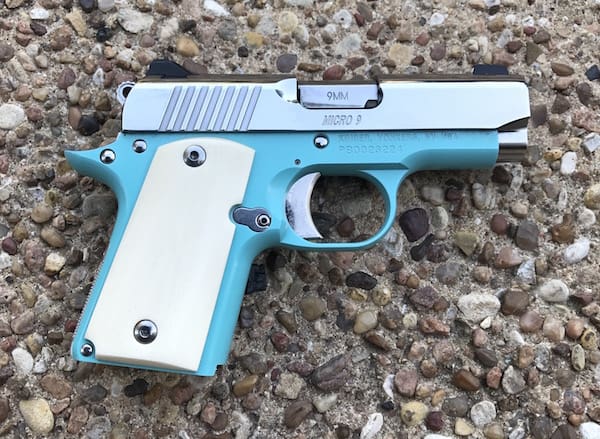
However, there’s a sometimes confusing array of these pocket rockets, made more complicated by the caliber choices, a point of contention among many gun owners. So let’s take a look at a few types, weighing the pros and cons of the three most common calibers these little guns.
If you’re a new gun owner, you’ve probably already picked up on the fact that debates over the “best” caliber for given gun are both common and at times rather heated. While too many people steadfastly insist that only one particular caliber is suitable for self defense, or dismiss a round simply because their buddies and the local gun store gossip group don’t think much of it, the reality is that there is no one ideal round.
While I have larger guns, my go-to small carry piece is a small Kel-Tec P32 in .32 ACP. A good friend favors a Ruger LCP II in .380. And for a while I was also carrying a 9mm SCCY CPX-2. Boom. Instant debate.
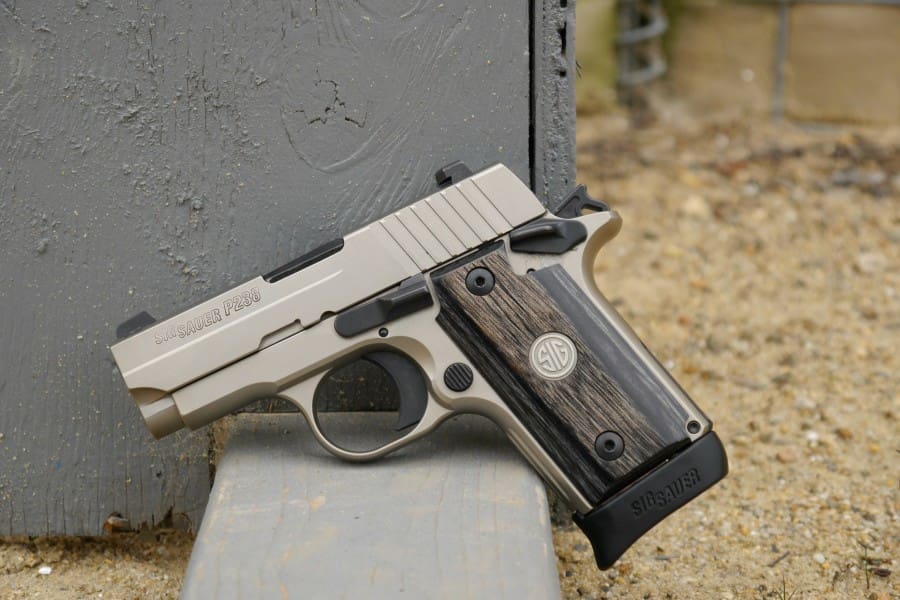
All three calibers have their pros and cons, and the simple truth is that there is no “best” round for all shooters in all situations. Your choice of a compact pistol is a tradeoff of budget, stopping power, and physical prowess. Each person will make different choices for different reasons, none of which is incorrect for them. So first, let’s examine the three rounds.
Our story begins as so many of these stories do, with John Moses Browning. Both the .32 and .380 were designed for early semi-automatic pistols at the dawn of the 20th century. It didn’t take long for them to find their way into smaller and smaller form factors. Around this same time, George Luger was pioneering the 9mm round which bears his name. However, it wasn’t until well after WWII that the 9mm became commonly used in the United States. And it wasn’t until the 1980’s — almost a century after it was first designed — that it became the uber-common cartridge that it is today.
When designing a pocket pistol, you have to balance size, weight, and recoil. Recoil is managed in pistols of this size through using small, less powerful cartridges. Felt recoil increases as size and weight decreases. At some point a level is reached where the felt recoil becomes excessive in relation to the size of the gun. There’s no cheating physics.
It’s worth noting also that all three cartridges we’re looking at weren’t designed for the short two- to three-inch barrels of common pocket pistols, but four-inch or longer barrels. Running these rounds through a shorter barrel increases muzzle flash and felt recoil, and at some level can become unpleasant to shoot. So what’s the practical difference between .32, .380 and 9mm? Well… a lot.

Prior to writing this article, my every day carry was a SCCY SPX-2 in 9mm. This gun, and similar ones like the Kel-Tec P-11, Kel-Tec PF-9, Ruger LC-9, Beretta Nano, and others are about the upper limit in size for a “pocket pistol” and the lower limit in size for a functional, small 9mm.
Some of these pistols come with double stack magazines offering 10 or 12 rounds while others are slimmer single stack designs. Like most common pocket pistols today, many 9mm guns are double action only, which means a trigger pull with a long takeup and a stiff break. That’s a safety feature that greatly reduces the chance of an unintended discharge.
So what’s it like shooting a tiny 9mm? Well, it depends. Because the 9mm is so popular with military, police, and private citizens alike, there is a huge array of ammo to choose from, including heavier bullets, and rounds operating at higher-than-standard pressures.

As a general rule, shooting standard pressure ammo with light bullets will give you reduced recoil, but also reduced stopping power. Most pocket 9mm pistols are rated for casual use with higher pressure +p loads, which basically means you should only shoot those when you have to.
When shot with high pressure loads, recoil, and muzzle blast will be severe. When shot with standard pressure loads, they will be lessened, but may still be unpleasant to shoot.
One thing to keep in mind, is that from a short barrel, you’re wasting a lot of the the 9mm round’s potential. While ammo like the Hornady Critical Defense 9mm is designed to work well in short barrel pistols and deliver less recoil and muzzle flash, such 9mm rounds are the exception. Still, if you’re comfortable with the recoil, there’s a lot to be said for small 9mm pistols, including a wide choice of inexpensive ammo.

A good friend of mine favors a .380 Ruger LCP II. This is a revised version of Ruger LCP, which many say is basically a copy of the Kel-Tec P-3AT. There are plenty of other tiny .380’s on the market like the Khar CW380, Taurus 738, Beretta Pico, or the Colt Mustang Lite. This is far from a comprehensive list, and with a bit of shopping, you can get into a modern, safe .380 pocket gun for under $200.
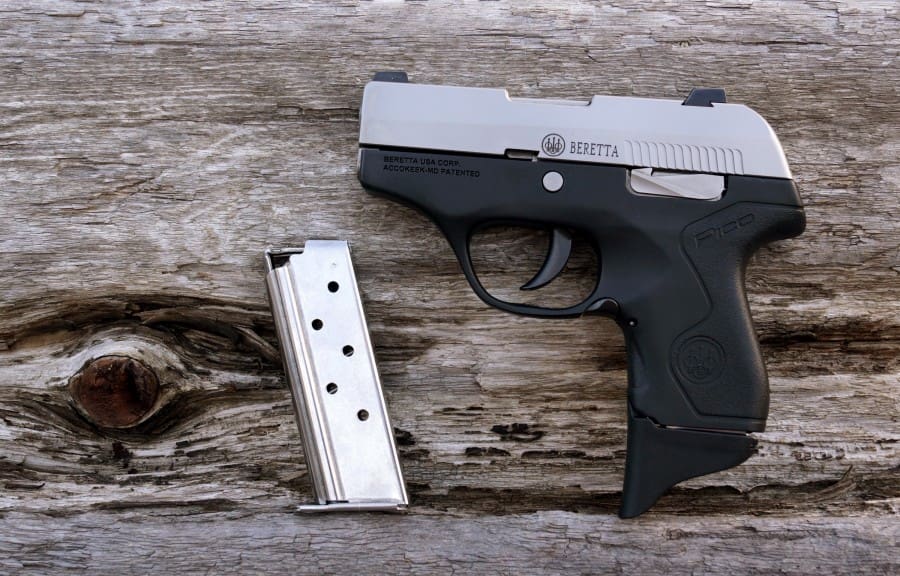
The physical form factor of the .380 round is almost the same as the 9mm (9x19mm vs 9x17mm), but the less powerful .380 can be built with a lighter slide and frame, making it a more popular caliber for tiny pistols. However, it’s also a real and sometimes literal pain to shoot.
My first introduction to a compact .380 was the original Ruger LCP about seven years ago. At the time I was shooting a .357 revolver and the LCP belonged to a friend. We both remarked that it was all but impossible to tell the difference between the recoil of the 6-inch .357 we were shooting and the tiny LCP. Again, Hornady makes reduced recoil Critical Defense loads, but you’ll find most .380 ammo can be quite stout in the recoil department.
Which brings us to the last caliber on the list, and my current every day carry choice, the .32 caliber pocket pistol. That same day I was shooting an LCP, I was also shooting the first of three different Kel-Tec P32’s I’ve owned.
I can already hear the scoffing. After all, the .32 pistol exemplifies the term “mouse gun” and is readily dismissed as underpowered and pointless. Aside from three different P32’s, I’ve owned four or five other .32’s of various flavors, ranging from cheap Saturday Night Specials, to Czech police sidearms, to a WWI issued French Ruby. Suffice it to say, I like the .32, and for good reason.
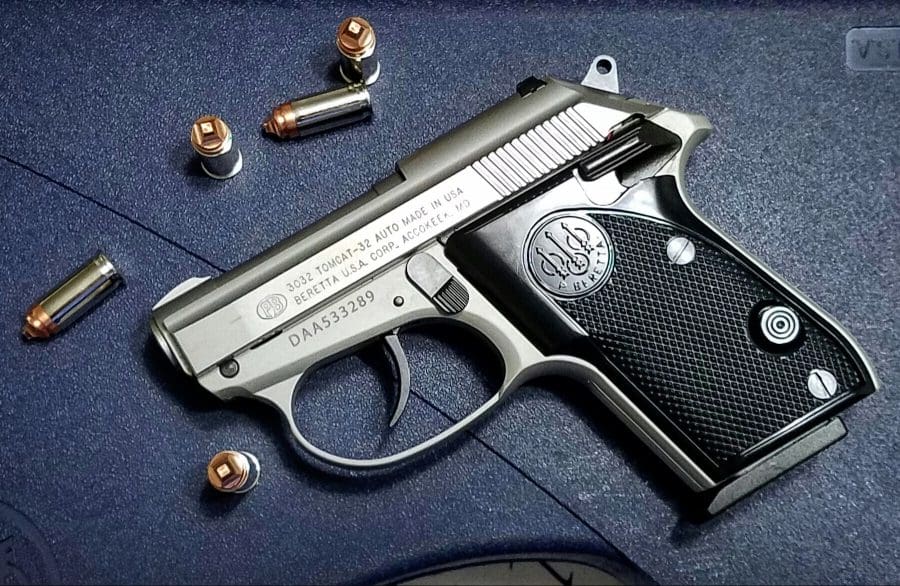
Of the three calibers on this list, the .32 alone offers minimal recoil, and is the easiest to shoot. It is also the rarest of the three guns. Most people figure, with more potent offerings in a similar size, why bother, with the weaker round?
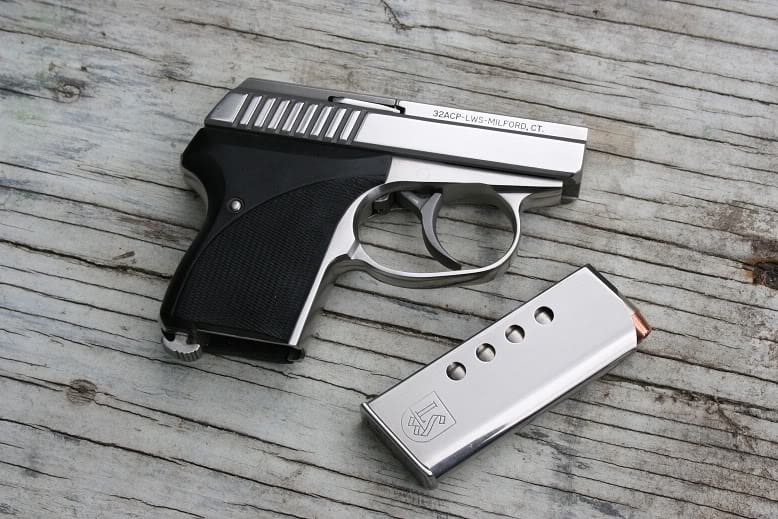
On the high end, the famous the Seecamp was literally designed around the surprisingly hard hitting 60 grain Winchester Silvertip .32, or you can choose the well made Beretta Tomcat. North American Arms, and Kel-Tec also make very nice and affordable .32’s.
So when faced with three different calibers with various pros and cons, ranging from recoil to stopping power, how do you choose?
While I’m physically capable of shooting any of the guns discussed here, not everyone is. In preparing this article I sat down with friends and acquaintances, and even did a little horse trading. My SCCY 9mm, went to a retired IBM programmer in trade for my current Kel-Tec, and some other goodies. I had the opportunity to work with a very nice Ruger LCP II, and a cute little pink Taurus .380. Sitting down with a diverse group of people with different ages and physical skills lead to some interesting observations.
When looking for a pocket pistol, size and recoil were the two things that mattered most. Skilled shooters regardless of age, and who were in decent physical health happily chose a .380 or 9mm. A woman in her 60’s who is a retired EMT packs a compact .380, while another person all but pounced on the .32 auto, any gun with stouter recoil would have been too much for her to handle.
A self described “urban farmer” with an abusive ex boyfriend finds great comfort in her .380. My friend with the LCP II chose it for discrete concealed carry and stopping power, over the slimmer, lighter .32. I choose the .32 for discretion, ease of use, and reduced wall penetration in case of a miss in close quarters.
A quick rundown shows that when size of the gun is the most important (many people choose a small pocket pistol for discrete carry), that larger calibers are favored when the person feels comfortable shooting them. Age isn’t a limitation on caliber size, in fact the oldest person in my non-scientific study chose the 9mm, and the second oldest has been a .380 fan for decades, and made her choice based on that, but appreciated the 9mm.
The size of a compact .32 was universally appreciated, but experienced shooters who could make other choices tended to opt for a .380 or 9mm. When choosing the .32, physical ability to handle recoil played big a role, as did the tiny size of the Kel-Tec. While the .32 can be very accurate, it typically lacks stopping power compared to other, larger calibers common in pocket guns.
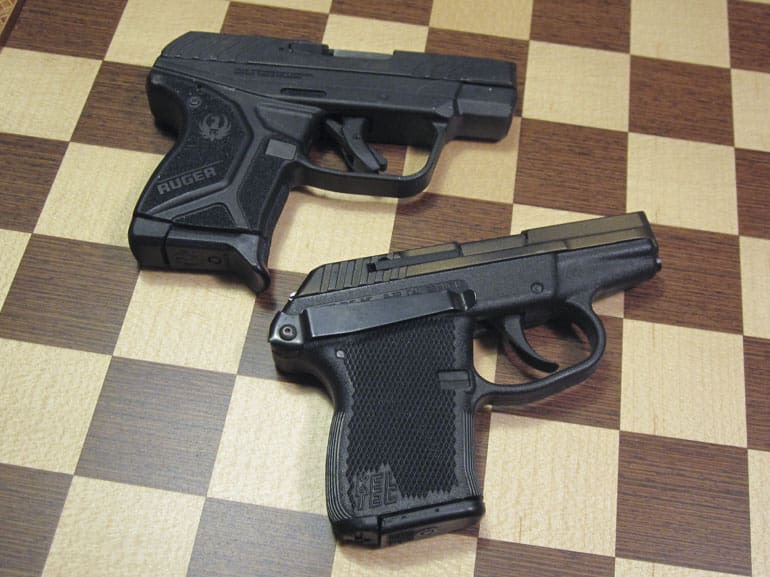
When you make the choice to buy a pocket gun for discrete concealed carry, there is no one correct answer. I’m physically capable of shooting large magnum revolvers, and regularly do so. But I gravitate to .32’s like a moth to a flame. If you favor easy shooting and accuracy over raw power, then it is an ideal gun, if you understand and accept the limitations that come with the round. Remember, having a gun is better than no gun, and there is no need to force yourself to carry a bigger gun if you are uncomfortable doing so.
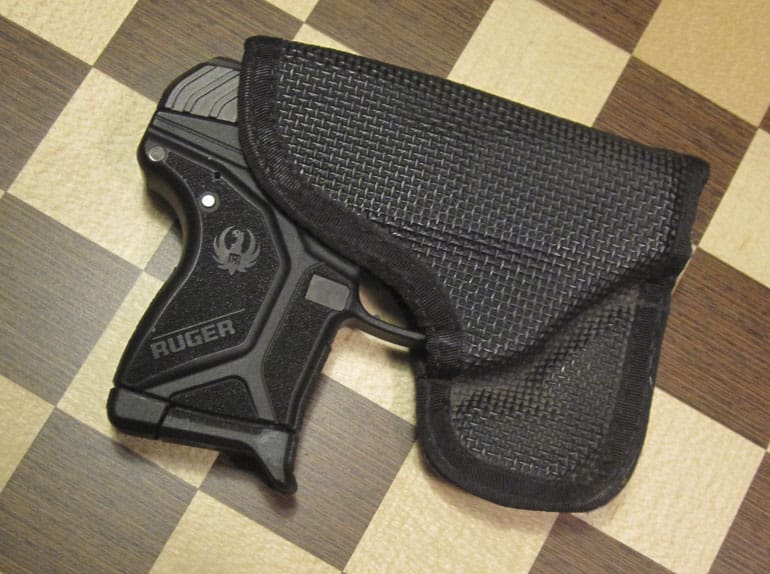
The .380 pocket gun rules the market for good reason. They are an ideal compromise between size, power and recoil. Many compact versions exist, and they’re easy to carry, and easy to shoot for most people. The market is awash with them, and they are incredibly popular with first-time gun buyers, as well as novice and skilled concealed carriers alike. While they have a strong bark, they also have a strong bite, and work well for self defense.
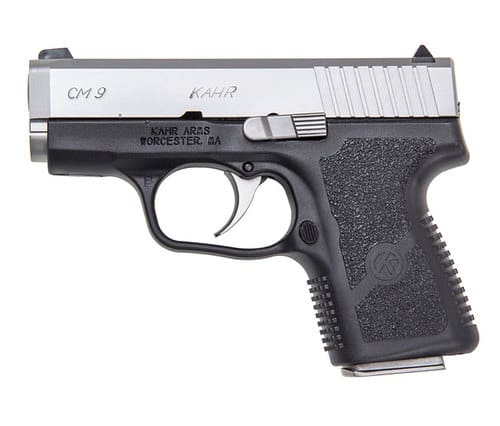
The same argument goes for the 9mm pocket guns, although they tend to run a bit larger than their .380 cousins. The ammo is widely available, there is incredible choice in bullet types, and the cost per round is lower than the .380. The main tradeoff here is the size of the gun, but at the same time, with several double stack models available holding 10 or more rounds, there’s something to be said for the increased choices in ammo capacity.
Choosing the right concealed carry pistol can be difficult and is always a highly personal one. Competing calibers, models, personal and professional opinions, physical ability, skill as a shooter and even culture all influence your choice of handgun.
If you’re a novice shooter, it can be even more difficult to make that first choice. Key to choosing a gun is what feels good in your hand, what you can handle, and what best fits your carry needs. There are plenty of options out there, and you can find an answer by simply balancing budget, skill, ability and comfort. And remember, having a gun is better than having no gun at all.
Photo credits:
Sccy 9mm- author
LCP II and LCP II/Kel Tec photos- Geoff Hicks
Girl holding Kel-Tec P32- Oleg Volk

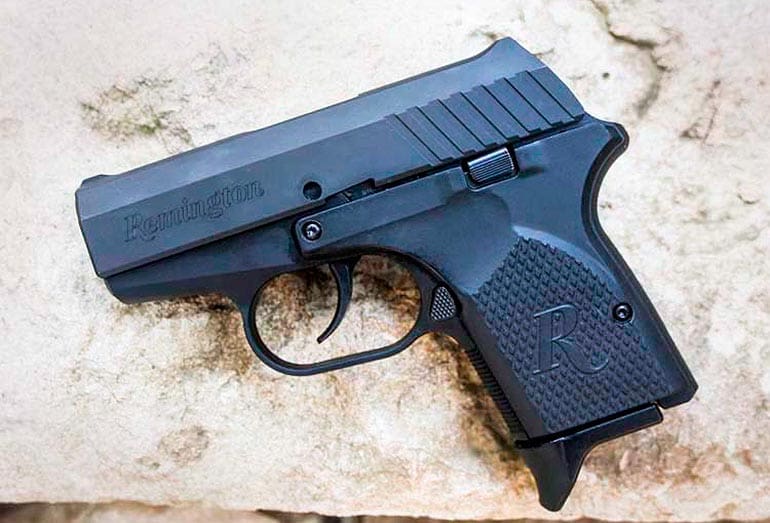



Make my “pocket rocket” a Khar CM40. More power than the 9, same size. TRULY a pocket rocket!
A gun blogger who admits to EDCing a low rate SCCY and then downgrades to a Kel Tec 32ACP is wholeheartedly admitting his opinion is ill informed and not to be taken seriously.
Go get a quality gun…
Thank you so much….that comment added so much to this conversation that I am simply amazed.
Pocket .380’s suck. The only thing that sucks more, is not having at least a pocket .380 on you.
Pocket 9mms also suck. In some ways they suck more, as they’re a bastard to shoot. But they’re at least a decently powerful caliber. Lousy capacity, big recoil, no fun.
The best 9mm pocket pistol requires slightly bigger pockets. Springfield XD Mod.2 9mm subcompact. 14 rounds on tap, a grip safety, and heavy enough that it really tames the recoil. Slightly wider grip accomodates a double-stack mag and really helps reduce felt recoil. Fits in my Dockers easily, and also fits in most of my jeans front pockets easily. Some jeans it’s a tad tight, and then I have to go back to the sucktacular pocket .380.
Friends don’t let friends Springfield.
“The only thing that sucks more, is not having at least a pocket .380 on you.”
^This.
What is the best caliber pocket carry gun? Answer: One you will actually carry.
I have friends with rather large (both size and caliber) ostensibly CCW guns…that they never carry. Too heavy, too hard to conceal during 112F weather, too this, too that. So they end up not carrying. They can laugh at my little SigP238 in when it is summer, but it meets the first rule: Have a gun. 😉
They only suck if you can’t shoot them. Most people can’t shoot them, do not train at all and know very little about guns. To say the 380 is not a deadly round is a real lack of knowledge.
It is obvious that you do not shoot very much. That is a common comment from Newbie shooters. Spend more time shooting them and they become extremely enjoyable to shoot.
642 for pocket carry all day, every day. F the 380.
442. The silver front sight is hard to see in bright daylight and no easier to see at night. Still a great second choice. That jab you felt was me poking fun. Great revolver.
Great pocket gun, was my first.
The 642 is the king of contact weapons; I carry one every day, even when it’s only my BUG. However, shooting +p at the range is about as much fun as whacking my hand with a 2X4. That’s why I stick to plain-jane .38spls, which also are stout in such a small revolver.
Same, often use B.B. 150gr 38spl for carry.
Ruger LCR (hammerless) with laser grip, in the somewhat hard-to-find .327 Federal. 100gr JHP at about 1500fps, lower recoil – actually far less painful for my arthritic hands. 6 shots. Midway and Brownells carry ammo in this caliber, plus it will also take .32 H&R and the .32 S&W Long/shorts – practically zero recoil for practice.
The Makarov round and handguns built for it are great CCW packages although the handguns are all metal and a little heavier than the plastic fantastics. Since they are heavier, they have less recoil, but are still snappy. Why were these not even mentioned?
A simple lack of popularity I guess… possibly also because the author has no experience with one.
Just doing a cursory glance around GunBroker to see what makarovs and clones are going for may give another clue; why spend that kind of money on a bigger, heavier, often lesser-quality gun with fewer ammunition choices when you can often spend as much or less on something more popular?
To each their own… I won’t even mention what kind of pipsqueak gun rode around in my pocket today because it’s sort of embarrassing, but it didn’t get mentioned in the article either.
🤠
The Maks and clones are excellent guns. I have one that is murphy proof.
But they have a limited range of decent brand name defense loads and the guns are all surplus. No new ones that I’m aware of.
Pipsqueak firearm, or sharp stick? Don’t hang your head. At least you had some standoff capability.
Eleven .22 slugs to the face will deter all but the most determined attackers.
If “The First 48” is anything to go by, .22 and .380 will kill you plenty dead, just maybe not right this second. .32 used to be widely considered plenty of gun and human biology hasn’t changed that much. trauma medicine is just faster and better.
I worked a scene one night here it was two bad guys. Argument over a card game. #1 did a zipper on #2. Took a Raven .25 and started just above #1’s belt buckle. Ended just under #2’s left eye. Took the fight right out of #2.
Just one man’s opinion, but I don’t see the point of .32 or .25acp. If you’re looking for a pocket pis tol that doesn’t rec oil like a 10 ounce .380 just go with .22LR. Either way you’ll need to pull the trig ger as fast as you can until it goes click.
According to TTAG “Ammo Review: Lehigh & Underwood Make .32 ACP Great Again” the 32 acp can pass the FBI penetration test.
FEG. PA -63. I really didn’t expect a 9×18 to be mentioned.
My Sig 238. Minimal recoil, fairly small in size, good accuracy, decent fit in larger pockets. My modified TCP. Very small, easily pocketed even in small pockets, quite accurate at the intended distances but a good bit of recoil. LCP2 as a rental. Quite nice overall if you practiced with it but again, a bit of recoil. I still say it’s about the size of your hands. If you have large hands, the micro .380’s are just too small. If your hands are weak, the .380’s have too much recoil. I don’t like small 9’s. For me the recoil reduces accuracy. I have a larger 9 with much less recoil and much greater accuracy. 9’s really should be “full size” although mine is considered “compact”. But a full size 9 does not conceal IWB for most people and definitely not for me unless oversize pants. For me, a .380 that fits my hands works best for concealment. For new shooters, how do you intend to carry it and in what type of clothing? Dress clothing or stylish/tight clothing begs for a small .380 or maybe even a .32 – deal with the recoil or realize the caliber is small and aim accordingly. Casual, baggy clothing or if you can carry OWB creates many more possibilities of “full size” handguns in whatever caliber and style interests you.
9mm is the smallest I’ll carry with a mebbe for a 38 snubby. I agree if yer talkin’ Keltec 32…😧😩😖😢
I think the only value the .380 (or smaller) have is in ‘marking’ a criminal so cops can find him later at the hospital. Otherwise the only stopping power they have is with a lucky head shot.
So you’re offering to take a couple .380 rounds center mass to prove that “the only stopping power they have is with a lucky head shot”?
Wow, that takes guts! And being shot with modern hollowpoints should leave your guts barely mussed, if they have as little power as you claim…
I must agree with shallnot. Check the penetration of even a critical defense 380. Center mass WILL kill you and you won’t know the difference between it or a 9. But if its a head shot you prefer, I consistently make headshots with a kahr P380. Training is everything. If you don’t train, you don’t know and you are talking out your ass.
I am a fan of small 9 mm pocket pistols, but with the very short barrels, I prefer to use a 124 gr. HP to any of the 147 gr offerings, since they have somewhat higher velocity and lower recoil. At first, a small 9 can feel like a bear, but it is nowhere near the recoil impulse of the Air Weight .357 snubbies–or heck, any .357 snubbie. After a few mags, one adapts to it easily. I do not find them painful to shoot. Mine is a 16 oz Kahr with a Hogue grip that takes away control issues.
All that said, I really don’t think that novices should start on a short barrelled pocket pistol. They require a bit of training to be accurate, and are definitely harder to control until you know that proper techniques. I haven’t tried out any of the .380 offerings, principally because California effectively banned all of the really small ones other than the larger and heavier Bersa.
I notice that Speer simply relabeled their 9mm 124gr. +P as their ‘short barrel’ load (I guess because it still achieves the 1150 fps velocity from a short barrel as their standard velocity load does in a longer barrel).
No, it’s not simply relabeled – they stock 124 gr.Personal Protection loads in both +P and Short Barrel +P. I’ve shot and chronographed both through my Kahr CM9, and the Short Barrel loads have slightly lower velocity – probably due to the low-flash powder they use in that load.
I wouldn’t want to get shot with either, so I’ll take the lower muzzle flash Short Barrel loads rather than 20-30 fps more. YMMV.
I will continue to carry the original micro 9mm. A Rohrbaugh R9. No sights, no external safety, 124 gr. Gold Dots, extra magazine in the same pocket, no worries.
It ain’t pleasant to shoot a lot, but that is not why I carry a gun. Got plenty of handguns that are softer shooting that could be carried, just not as easily and concealable.
If I can find one here in the glorious peoples republic I will buy a Beretta .25. Cause I want one and don’t figure I need any other reason.
Okay, You said, “Compact Concealed Carry Pistols: Guns and Calibers For Beginners.” I’m sorry to disagree, but small handguns in the hands of a beginner is almost always a mistake. In my experience starting a beginner with a .22 auto pistol is perfect. Ruger, High Standard, Colt Woodsman, etc. Once the basics are established, trigger control, sight alignment, step up to a medium frame/caliber handgun. Glock 17/K frame .38. Once those are mastered go down to the sub-compacts. I wish I had a steak dinner, rare, for every man that asked me advice on what they should buy their wife/girlfriend. They always want something “small and easy to shoot.” That’s an oxymoron. Shorter sight radius, more recoil and muzzle blast in any given caliber. The sub-compacts belong in the hands of the experienced shooters. This was brought home to me when I took my wife out to shoot her new Mod. 60 that I had bought her. She was not doing well and she was not a beginner. I handed her a Glock 19 and she started ringing those Pepper Poppers like the dinner bell. She said, “You can keep that little thing. I like this.” I bought her a slightly larger Galco purse for her birthday.
You nailed it. Pocket pistols are for experienced shooters, more so than a 1911. The best pistol for a new carrier is a compact like a XD/m or the new Beretta APX.
I Love My 9mm Springfield XD(M) 3.8in Bi-Tone!!!
Paul,
Your comments are spot on if someone is concerned about marksmanship at distances of 20 feet and farther out.
If someone merely wants the ability to fend off an attacker at contact distance, the sub-compact pocket pistols in .32 ACP, .380 ACP, and 9mm are just fine for beginners.
As for the potentially sharp recoil of such sub-compact pistols, the operator will not care when they are shooting at an attacker. The mantra that, “these pistols are meant to be carried a lot and shot a little,” applies especially well for concealed carry beginners.
My advice has always been carry the biggest gun you can. Not always easy in Florida. As I write this it’s 81. The only reason it’s not 91 is that it’s overcast today. Most women I know that carry concealed carry in their purse. (One dedicated to firearms carry, please.) So why not carry a medium frame handgun that is easier to shoot and hit with at any range?
The Denver Uber driver dumped 10 rounds at the guy next to him in a car. Unless it’s a contact shot the P(hit) is going to be less than 1. You will have a higher hit probability at virtually any range with a larger gun.
Absolutely correct.
My wife and I started with a Ruger .22 then a 38 before a .380.
Bought my wife a Ruger LCP. I find it not too bad as far as accuracy. (hate the trigger )
Wife has trouble racking (it is a bit awkward) so she won’t use it.
Bought an LC9 based on reviews. Mistake, should have waited to buy the striker version.
I carry the LCP when I am allowed (in Florida) but shoot other guns for fun.
For the most part I agree, small guns are experts weapons. However, I think it’s less about the small size itself or the extra recoil that comes with the reduced weight and is more about the way most micro guns are designed. They almost universally have heavy double action triggers and tiny, low profile hard to use sights. Those two things combined make a gun a challenge to shoot well regardless of its size. Finding a good choice for a beginner ccw, in my humble opinion, means going as small as possible without giving up the feel and ease of use of a larger gun. To me this means things like g42/43, g26, xds, pps, shields etc. small enough to carry every day, but the features of a larger gun.
It takes skill to shoot a mousegun well. Are there mousegun competitions? Either bullseye contests or IDPA type things? I think that would be fun. I’d shoot a P-3AT competitively, but nobody else at the club admits to having any pistol that small.
My beretta 950 sao 25acp is a tack driver. I would love to compete in a class like that
I shoot my LCP2 better than my Shield. My wife actually missed the target with the Shield yesterday and did pretty good with the LCP2. I would sell the Shield if I didn’t have a self imposed ban on selling guns. I just don’t.
We both love our SR9C if you don’t mind a double stack. I never really understood why people trashed guns based on a trigger until I shot the SR9C and Shield back to back.
I don’t feel so much difference in size and weight between my khar in 380 and my Taurus pt111 in 9 so I carry the Taurus most of the time. 13 rounds in an accurate compact gun seems the best choice for me
The heck with the caliber all 3 stink in a short barrel. I haven’t heard a word here about beginner or not.
Shooting a pocket pistol at even bad breath distance isn’t all that easy.
Other then point and shoot hope you hit something.
Even a beginner should get as some here have already said. A real gun and learn to shoot 1st. Small comes later not at the beginning.
Jay in Florida,
“… all 3 [calibers] stink in a short barrel.”
All handgun calibers are unable to reliably cause PHYSICAL incapacitation with one or two hits. Nevertheless, all handgun calibers are quite reliable at causing “psychological stops” — about 95% or more of attackers will break-off their attack when the victim starts shooting ANY CALIBER at them. Thus, .32 ACP, .380 ACP, and 9mm are fine self-defense calibers (regardless of barrel length) for something like 95% of attacks.
“Shooting a pocket pistol at even bad breath distance isn’t all that easy.”
I do not agree. Regardless, a large handgun in a larger caliber is not going to be any easier to shoot at contact distance. In fact I will argue that a larger handgun is a potential liability at contact distances because the attacker can get a better grip and apply more force on a larger handgun if the attacker decides to go for your firearm.
And even if the attacker does not notice or care about your firearm, it might be very difficult for the victim to point a large handgun at an attacker who is on top of him/her in a tight space. In that instance, a sub-compact handgun could be a serious asset.
I’m trying to understand he problem of too strong kick with 9mm… I have a glock 43 and a sig p938 (cause it looks awesome)… I alternate practice with them on the range and while the glock trigger starts digging in to my finger after a while, the kick on either is not bad.
The glock is my carry because which gun would I cry about less if it gets taken into evidence after a defensive use?
Anyone complaining of kick go fire a xds 45… after that the 9 will feel like a feater’s kiss.
No kidding about the XDs. It’s easy to keep on target because it doesn’t “buck” like many .45s, but the recoil sends it straight back into your palm and wrist, and after about fifty rounds your shooting hand will start trembling like the Waco Kid’s in Blazing Saddles. Lot of power in a tiny package, but it’s definitely not the pistol to take along if you’re just looking to show some soda cans who’s boss.
Hmmm… mine kicked like a mule, up and to the side, not straight back. But to be honest, the last time I exercised was 1998 🙂
CZ-82’s and Makarov’s are quality, well built 9mm Maks (9×18). Both are accurate and a joy to shoot. Also, the Polish P-64 is a well built 9mm Mak tho a bit “snappy” as it is considerably smaller than the 82 or the Makarov. The Hungarian PA-63 shooting 9mm Mak is sho nuff a handful as it is very light. Hornady markets Critical Defense in 9×18 Mak. Having said all of that, my EDC favorite is becoming a Ruger LCR (or LCRx with exposed hammer depending on which one I choose on a given day) in .327 Federal Magnum. Both have 1.87 in barrel and they are trim for revolvers and easy to conceal carry. My trail/woods tromping piece is a Rugged SP-101 with 3 inch barrel in, you guessed it, .327 Fed Mag. .327 Fed Mag is a .32 with big time punch, 6 rounds in the cylinder, and reduced recoil. Google .327 Federal Magnum and read up on the round. It’s a badass cartridge.
“Stopping power.”
Everybody drink.
I recently bought a Sig P224. I can’t recommend it as a first gun. I really like it but it definitely has a long trigger pull.
I won’t carry anything smaller than my Ruger LC9s. -If you have to put a large pinky extender on a mouse gun to shoot with any sort of accuracy, why not carry more gun in the same space?
My wife had bad carpal tunnel from being a postal sorter for 35 years. I bought her a 32 Tomcat soon after we became an item, mainly for it’s tip up barrel and low recoil. She has had her hands operated on and can rack and shoot my 9’s and 40’s but I don’t think she will ever give up her heavy little Tomcat. She is confident with it and shoots it well. The only downside is the dern cost of 32 ammo but I don’t care she can plink and practice as much as she wants, I will shoot the the cheaper stuff.
For pocket carry, I’ll stick with my 938 SAS.
Bersa Thunder 380
+1
Keep in mind that the Bersa Thunder series is a little bit heavier than the sub-compact polymer pistols and probably too bulky to carry in many pants pockets. Even so, they fit into small holsters that are pretty easy to conceal on your belt.
Bersa Thunder pistols sure do tame recoil, though. And I can shoot 5-inch diameter circles at 50 feet with surprising regularity — something that I definitely cannot do with sub-compact polymer pistols.
Caveat: while the ability to shoot 5-inch circles at 50 feet is FUN, it is not necessary to fend-off an attacker who is 6 feet away — a task which sub-compact polymer pistols handle just fine.
The first gun pictured, the Remington RM380, is one that big green actually does right.
What about the .327 magnum? I have never shot one but am curious as to what people think who have shot them? I saw a Ruger .327 with a 3 inch barrel in a gun shop recently, which looked fairly compact.
Thanks
Bill
.327 Fed Mag is a very good round. Google it for info.
I like my P3AT even if NO one else does. It’s never jammed. It’s loaded with hydra shoks. I’m sure It would take the fight out of anyone.
A .32 or .380 for self defense? Bah. Every internet expert knows that shooting someone in the face or chest with a .32 or .380 will only make them stronger. In fact, skip the gym, shoot yourself 6 times in the gut with a .32 to obtain rock solid abs. If you’re not carrying a Glock, 9mm minimum, in your hand, continuously pointed at every bystander who doesn’t have their hands clearly visible (finger off the trigger of course, safety first after all), then you have already lost. May as well never leave your home. Oh, and you better have at least 4, 15 round, mags on you at all times. What’s that, your state only allows 10 round mags? I’m sorry to say but you will most likely be killed shortly after finishing this sentence. Possibly by the fellow standing right behind you.
I recall a time mid 70’s when every knowledgable gun writer scoffed at the 9 x 19 said it would only make a bad guy giggle, you needed a .357 mag, or better yet a .45 acp to really defend yourself LOL. Times and facts change.
LOL
LOL
It’s been hot in North Texas, so the LCP has been my go-to carry choice lately…
If swamp a$$ is in the forecast, I’m likely to bust out the pocket gun and shorts.
Anyone that has had someone pull a gun out on them .and they had the time to get to there gun .they better shoot quick but most of all they better be shooting a gun they can follow up with .in case you miss in the heat of the moment you can get that 2nd shot off quick .remember you are probably gonna be 4-5 feet away from guy or less .2 quick shots out of 32 cal they are going down .especially if you are a advid shooter sometimes less is better TALKING FROM EXPERIENCE BEN THERE
I’m guessing somebody isn’t a Taurus fan.
My EDC is a Taurus PT111 Millennium G2 9mm. 12+1.
VERY accurate at 7 yards. On a B-27 everything in the X and 10 ring.
The Taurus TCP 738 was a very good and accurate little gun. It was magazine sensitive. The mag that came with it made in Brazil failed to feed every single time I used it, the made in Italy Mecgar would fail to feed often enough to be scary the made in USA mag never failed.
I had three mags nd only one was reliable enough to carry. Good gun poor magazines, I swapped it for the Ruger LCP II I have now.
Taurus pt111 g2 is the best 250$ I ever spent. Over a thousand rounds WITHOUT cleaning and zero failures. I even staggered different loads with steel case ammo and it will not fail. Second strike capability. 12+1 9mm. Very easy to carry and rounded corners everywhere for an easy draw. I cant understand why Taurus gets a bad rap.
It looks as though most of the comments here and the post was primarily referencing pistols that actually are placed inside ones pants pocket for concealment of a daily carry and of coarse this generally minimizes bullet size/ weight to one of the smaller calibers mentioned . There are some fine guns in larger calibers that can be carried in ones pocket , but limited for sure .
I absolutely can’t stand the weight in a pocket , my keys are about as heavy as I can stand , albeit I do carry around 17 keys on my everyday key bob , so all these choices are out for me , but for a small pistol that could be carried in a pocket , or ladies purse , that is reliable , durable , accurate , and can be quite potent , my hands down choice is the SR9C , by Ruger . The 17 round mag can be accessorized .
For the lightest pistol with the most fire power , without an extended magazine , I would recommend the PMR 30 , by Kel Tec . 30 plus one , 40 grain , HV HP Speer Gold dots at nearly 275 foot pounds energy each from a 4.5 inch bbl. , placed accurately into vital areas , from a full size pistol weighing a bit over a pound , loaded , is a formidable deterrent against multiple attackers , and add a couple extra loaded magazines for almost 100 rounds , that should let you get from wherever you are and back to the safety of your gun vault .
I started carrying years ago , 357 mag revolvers , went to various 9mm’s , and then came the PMR 30 . Took me about 17 months to fully convert , but I have no regrets , Mine are reliable , accurate , comfortable and always loaded .
Go with a HK PV9SK, 9mm. Good grip, light weight, small enough to put in pocket or coat. Go to the range and get familiar it. Make your carry gun, no matter what it is, your “no problem” go to gun.
I also carry a Glock 30, but not often because its rather heavy in the pocket.
If I knew I was going into a shootout I would carry a rifle, since I do not normally get into shoot outs I use a Handgun, for the house a .357 mag. Or a .45 acp.
Now for CCW I carry a .380 acp Ruger LCP II because experience shows I will carry more than shoot. Now if asked for advice I would recommend a small 9 x19 mm Glock because you can buy a whole line of handguns just a like for everything small carry medium general use and even larger for hunting.
I would not turn down a good reliable .32 acp and in fact I have and do at times carry an old Galesi_Brescia in .25 acp inheirted from my Aunt who carried it from 1965 till the day she died in 2000 at 88 yrs old, she even used it several times in defense against her sisters ex and local Union thugs who accosted her due to her anti union husband who was at work during nights.
I was trained by the Marines, I can at combat close range 25 feet put sevearl shots in the sinus area of a target no matter what caliber I use. Hits stop, misses don’t and a brain shot with anything that penetrates will kill.
I agree with the author’s assessment regarding the Kel-Tec P32. I carry one at all times. Always been reliable. The .32ACP started WWI and ended WWII.
Not to be a jerk, but that particular fn m1910 was chambered in 380. I don’t mean to take away from your argument, 32 acp has killed plenty over the years and I have a p32 in my pocket as I type this.
i wrote a guest article called “pocket pistol round-up” a few years ago, discussing guns such as the Seecamp .32, Kahr P380, keltec P-32 and P3AT, and the Colt Mustang Pocketlite (the aluminum version).
Back then i had tried the orgnal LCP and its trigger sucked, a trait shared along with many of the other common brand tiny .380s at the time. the overall best guns on my list were the Kahr and the Colt. The Kahr stopped going into battery after a fair amount of rounds, and a trip to the factory didn’t completely cure it. The metal version of the Mustang (apparently not manufactured anymore in favor of the polymer Mustang XSP) was and is great, but it’s too thick for back pocket “wallet carry”.
Today my favorite pocket pistol is the magnifcent LCP II. Smaller in every dimension than the Colt yet with a good trigger similar to the Colt, it fits flatly in the back pocket in an Uncle George’s P380 holster (note: Uncle George strongly recommends against the LCP II because he believes the trigger is too light; I disagree and think it’s perfect).
As a pocket gun enthusiast, I will agree and disagree with the author. Yes, Pocket guns are for the advanced shooter. They require diligent training and practice. I own a number of pocket guns, have shot all of them. Forget the Ruger LCP. High Recoil, and a horrible high five slap. A much over rated firearm. And Ruger builds these with a aluminum chassis. They will not last long with a lot of ammo down range. I owned 4 of them and they all just end up cracking apart etc.
My choice hands down is the Beretta Pico. A really top shelve build. Stainless Steel throughout the gun. Best sights in class, can easily add night sights. Magazines that look like high end custom 1911 and even a stainless steel follower. Double strike capable. Modular design, Easy take down.
And a extremely mild shooter. I mean VERY mild. With little muzzle flip.Plus P rated. And totally flawless shooting. They are built like a tank. Spend some time with the gun and you will reap great rewards. But no, they are not for the beginner. No pocket is. Short barrel, small guns require there own class.
It would be really helpful if you captioned your photos for those of us that don’t know every weapon by sight alone.
Comments are closed.